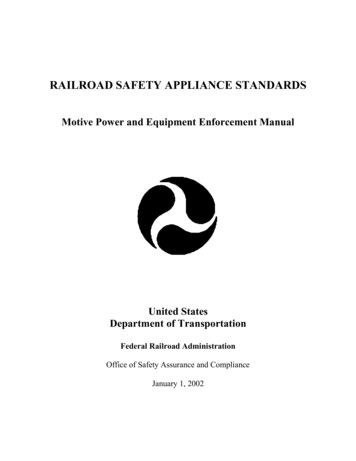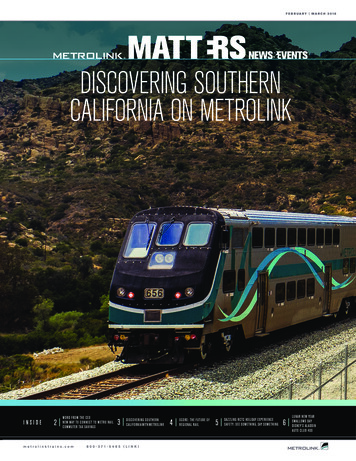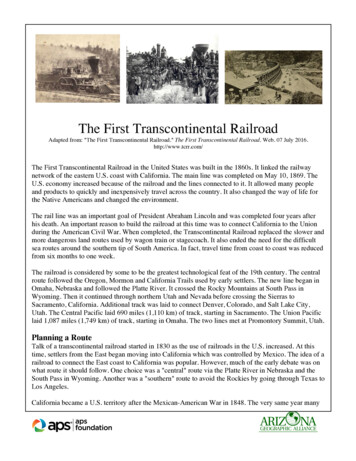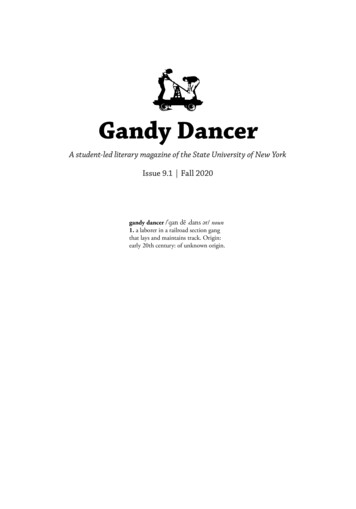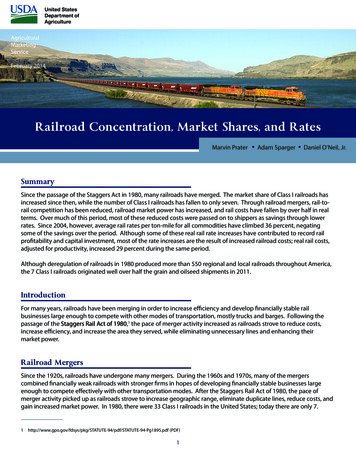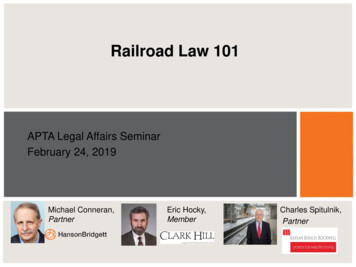
Transcription
Railroad Law 101APTA Legal Affairs SeminarFebruary 24, 2019Michael Conneran,PartnerEric Hocky,MemberCharles Spitulnik,Partner
THE BASICS Surface Transportation BoardFederal Railroad AdministrationLabor IssuesThe Courts - FELA2
Interstate Commerce Act of 1887 Imposed regulation of railroads: Prohibited discrimination among shippers Required publication of rates3
Deregulation – 1976-1995 Combatting “the disappearing railroad blues,” Congressenacted new laws aimed at making railroads solvent: 4R Act (1976) – Fewer controls on rates Staggers Rail Act of 1980– More deregulation, allowsrailroads to share tracks Interstate Commerce Commission Termination Act (ICCTA) of19954
ICCTA of 1995 Abolished Interstate Commerce Commission (ICC) Established Surface Transportation Board (STB) under theU.S. Department of Transportation– Now independent based on recent legislative changes More limited control of rail operations by federal agency5
STB6
The STB Jurisdiction: Interstate Commerce– Rail (all), Water (some), Motor Carrier (some)– “exclusive and plenary”– Commerce – rates; sales, leases and use agreements;abandonments7
Other Agencies Federal Railroad Administration (FRA) – Safety Agency thatregulates tracks, vehicles, speeds, and conducts safetyinspections State Public Utilities Commission (PUC)8
Basics for Federal Jurisdiction Commerce Clause – Art. I, §8, Cl. 3 Supremacy Clause – Art. VI, Cl. 29
PREEMPTION –– 49 U.S.C. 10502– 49 U.S.C. 1132110
Federal Pre-Emption Remember the key words: “exclusive and plenary” Chicago and North Western Transportation Company v. KaloBrick and Tile Co. (1991) 450 U.S. 311:“The ICA is among the most pervasive and comprehensive offederal regulatory schemes . . . . Since the turn of the century, wehave frequently invalidated attempts by the States to impose oncommon carriers obligations that are plainly inconsistent with theplenary authority of the [ICC] . . .”11
Federal Pre-Emption Chicago and North Western Transportation Company v. KaloBrick and Tile Co. (1991) 450 U.S. 311:“[There] can be no divided authority over interstate commerce, and. . . the acts of Congress on that subject are supreme andexclusive. [Citation.] Consequently, state efforts to regulatecommerce must fall when they conflict with or interfere with federalauthority over the same activity.”(Id. at 318-9.)12
It’s all about safety 49 U.S.C. §20106:– National Uniformity of Regulation– Preemption of State Law13
49 CFR Part 209, Appendix A Joint Use of Rail Lines “Connection” of “electric interurban rail system” to interstaterail system14
What is an Interstate Carrier? ActiveDiscontinuedAbandoned (not the same as easement abandonment)Rails to Trails (“Railbanking”)– Grantwood Village v. MissouriPacific Railroad Company Railroads that look wholly Intrastate Tourist railroads, plant railroads not included (not point-topoint)15
Railway Labor: Also a World Unto Itself Railway Labor Act, National Mediation Board Railroad Retirement/Railroad Unemployment Insurance LABOR PROTECTION––––STBCollective BargainingTransit IndustryFELA16
ICCTA PREEMPTION – 49 USC 10501(b) The jurisdiction of the Board over (1) transportation by rail carriers, and the remedies provided in this partwith respect to rates, classifications, rules (including car service,interchange, and other operating rules), practices, routes, services, andfacilities of such carriers; and(2) the construction, acquisition, operation, abandonment, ordiscontinuance of spur, industrial, team, switching, or side tracks, orfacilities, even if the tracks are located, or intended to be located,entirely in one State, is exclusive. Except as otherwise provided in thispart, the remedies provided under this part with respect to regulation ofrail transportation are exclusive and preempt the remedies providedunder Federal or State law.17
A Preemption Overview Generally Courts have classified preemption as Express: The statute specifically contains preemptionlanguage such as 49 USC 10501(b). Implied: This category in turn consists of field preemptionwhere federal law so thoroughly occupies the area that thereis no room for state or local regulation: STB jurisdiction overrailroad rates and service, mergers, and industry entry/exitand conflict preemption where federal law only displacesstate or local law at odds.18
Concurrent Jurisdiction STB and Courts have concurrent jurisdiction to considermatters of ICCTA preemption. 14500 Limited LLC, STBFinance Docket No. 35788, at 2 (June 5, 2014); Elam v. Kan.City S. Ry., 635 F.3d 796, 811 (5th Cir. 2011); City of Girard v.Youngstown Belt Ry. Co., 979 N.E.2d 1273, 1280 (Ohio2012). However, STB will typically decline to exercise its jurisdiction ifthe matter is already pending before a court, unless the courtasks for the STB’s views. Maumee & W. R.R. Corp., STBFinance Docket No. 34354, at 2-3 (Mar. 3, 2004).19
STB’s view of preemption The STB typically analyzes a preemption claims as eithercategorical in which conflicting regulation is per se prohibitedor as applied requiring a detailed factual analysis. Seediscussion in Thomas Tibbs, et al – Petition for DeclaratoryOrder, FD 35792, served 10/31/2014 (damage suit forproperty damage due to flooding caused by railroadmaintenance preempted) State or local regulation may be preempted “as applied” asregulating, unreasonably burdening, or interfering with railtransportation. This is a very fact specific analysis.20
City of Auburn v Surface TransportationBoard, 154 F.3d 1025 (9th Cir. 1998)Auburn:Cities file legal challenges to there-opening of Stampede Passline 229 miles through theCascades Auburn at Western terminus– near Seattle N/S line21
City of Auburn v Surface TransportationBoard, 154 F.3d 1025 (9th Cir. 1998)BNSF sought STB approval to reacquire line it had sold to shortline operator and segment it used only for local traffic STB prepared Environmental Assessment (EA) underNational Environmental Policy Act (NEPA)22
City of Auburn v Surface TransportationBoard, 154 F.3d 1025 (9th Cir. 1998)City challenged STB decision that found that:i.Local environment permitting laws were preempted byICCTAii. STB’s reliance on Environmental Assessment(i.e. finding that no Environmental Impact Statement(EIS) needed to be prepared)23
City of Auburn v Surface TransportationBoard, 154 F.3d 1025 (9th Cir. 1998)City of Auburn contentions on appeal to 9th Circuit: City claims no express preemption of local regulation:– Says Congress meant to preempt economic regulation, not“essential local police power required to protect the health orsafety of citizens.”24
City of Auburn v Surface TransportationBoard, 154 F.3d 1025 (9th Cir. 1998)Court rejects City’s position--opinion notes long history of judicialrecognition that rail operations need to be regulated at thefederal, not local, level25
City of Auburn v Surface TransportationBoard, 154 F.3d 1025 (9th Cir. 1998)Auburn court cited Chicago and North Western TransportationCompany v. Kalo Brick and Tile Company: Interstate Commerce Act (ICA) is “among the most persuasiveand comprehensive federal regulatory schemes” (450 U.S.311,318)26
City of Auburn v Surface TransportationBoard, 154 F.3d 1025 (9th Cir. 1998)Auburn court noted that STB also has exclusive authority overrail line mergers and acquisitions and stated: “[A] rail carrier participating in that approved or exemptedtransaction is exempt from . . . all other law, including stateand municipal law ”27
City of Auburn v Surface TransportationBoard, 154 F.3d 1025 (9th Cir. 1998)Also rejected City’s NEPA challenge, finding the EnvironmentalAssessment was adequate and the preparation of anEnvironmental Impact Statement was not required.28
Who Can Claim Preemption? The activity must constitute transportation by an STB-licensedrail carrier. Tri-State Brick and Stone Petition for DeclaratoryOrder, FD 34824 (STB served Dec. 11, 2007). See discussionat slide 32 about activities facilitating transportation. By rail carriers and non-operating owners of rail lines. NewYork City Economic Development Corporation - Petition forDeclaratory Order, FD 34429 (STB-served July 15, 2004). And operating in interstate commerce subject to STBjurisdiction.29
Does Not Cover Tenants of railroad landowners, Florida East Coast Ry. v. Cityof Palm Beach, 110 F. Supp.2d 1367 (S.D. Fla. 2000). Rail customers, SEA-3, Inc.-Petition for Declaratory Order, FD35853 (STB-served March 17, 2015); Hi-Tech Transportationv. NJ, 382 F.3d 295 (3d Cir. 2004). Landowners crossed by a common carrier rail line, JGBProperties, LLC-Petition for Declaratory Order, FD 35817(STB-served May 22, 2015).30
Does Not Cover, con’t Non-common carrier activities of railroads. New England Transrail,LLC, d/b/a Wilmington and Woburn Terminal Railway Construction,FD 34797 (STB-served July 10, 2007) (activities must be “integrallyrelated” to transportation); But compare Del Grasso –Petition forDeclaratory Order, FD 35652, 7/31/2017 (activities such as bagging,palletizing, and shrink-wrapping of the wood pellets come within thebroad statutory definition of “transportation” at § 10102(9) becausethey facilitate transportation). Car storage. Solid Waste, contaminated dirt, and construction and demolitiondebris (“C&D”) unless moving in original sealed containers.31
Does Not Cover, con’t “Public transportation” (by rail) provided by a “localgovernment authority” – i.e., Public Transit – is generallyoutside the jurisdiction of the STB, and generally not eligiblefor preemption. 49 USC 10501(c)(2); Peninsula Corridor JointPowers Board-Petition for Declaratory Order, FD 35929 (STBserved July 2, 2015).32
Then why worry about preemption? Shared rights of way with freight railroad. Shared tracks with freight railroad. Crossings between transit rail and freight rail lines. Desire or need for additional property owned by freightrailroad.33
Connected to the freight network, forbetter Preemption for construction of improvements that will benefitfreight railroad as well as transit – exemption from local andstate regulations (including environmental).– Construction of passing siding by agency / owner of right of wayand tracks with freight easement. North San Diego TransitBoard, FD 34111 (STB- served August 21, 2002)(preemptionapplies because improvements benefit freight service (andAmtrak).– Stabilization and repair of right of way owned by 2 passengeragencies. Northwest Pacific Railroad, FD 35977 (STB-servedApril 25, 2016) (guidance only that suggests preemption of Calif.Environmental Quality Act based on other cited decisions).34
For better, con’tBut, compare –– Electrification for commuter services; Calif. EnvironmentalQuality Act not preempted. Peninsula Corridor Joint Powers Bd.,FD 35929 (STB-served July 2, 2015)(owner subject to masstransit exemption; electrification no impact on the freight carrier).35
and for worse Inability to restrict or interfere with freight rail operations.North Coast Railroad Authority and Northwestern PacificRailroad Company v. Sonoma-Marin Area Rail Transit District,FD 36077 and NOR 42148 (STB-served November 3, 2016)(interim decision requesting additional information). Limited ability to condemn railroad rights of way. Union PacificR. Co. v. Chicago Transit Authority, 647 F.3d 675 (7th Cir.2011)(transit agency denied condemnation of freight railroadright of way that was being leased by agency).36
Condemnation of freight rail propertygenerally The STB and some courts have ruled that condemnation is aform of “regulation” and thus preempted. Norfolk SouthernPetition for Declaratory Relief, FD 35196 (March 1,2010)(condemnation of railroad property for a park); Soo Line;Chicago Transit Authority v. UP. Limited ability to condemn if rights sought do not interfere withthe target carrier’s ability to provide rail service (including rightof way maintenance and possible expansion needs). But totest that, you will need to seek a declaratory ruling from theSTB and the railroad will likely challenge your petition.37
Condemnation generally, con’tSo what’s the standard?Maumee & Western teaches us:“Routine, non-conflicting uses, such as non-exclusive easementsfor at-grade road crossings, wire crossings, sewer crossings,etc., are not preempted so long as they would not impede railoperations or pose undue safety risks.”38
Condemnation generally, con’t Political subdivision versus utility condemnation claims Categorical preemption versus as applied preemption Soo Line v. City of St Paul, 827 F. Supp.2d 1017 (D. Minn.2010)(categorical)(pedestrian trail)(railroad won) Illinois State Toll Highway Authority-Petition for DeclaratoryOrder, FD 36075, Jan. 17, 2017 (pending case involvingcondemnation of rail yard for highway construction)39
Condemnation generally, con’tExamples of successful condemnations: Easement for road crossing and subsurface utilities. Maumee& Western Railroad Corporation And RMW Ventures, LLCPetition For Declaratory Order, FD 34354 (STB-served March3, 2004)(railroad lost) Easement for underground sewer line. Eastern AlabamaRailway, LLC-Petition for Declaratory Order, FD 35583 (STBserved Feb. 22, 2012)(railroad lost)40
Condemnation generally, con’tExamples of unsuccessful condemnations: A 20’ wide five block long easement along right of way for apedestrian/bike trail and storm drainage improvements. City ofLincoln Petition for Declaratory Relief, FD34425 (STB-servedDec. 8, 2003)(railroad won the first time). A parcel of railroad property for use as a public park inBirmingham, AL. Norfolk Southern Railway Company Petitionfor A Declaratory Order, FD 35196 (STB-served March 1,2010)(railroad won).41
Condemnation generally, con’tWhat About: Condemnation of operating rights over rail freight line forpassenger service? Use of adjoining right of way for high voltage electric lineswhere railroad claims electrical interference?42
Options for transit providers: State or local agencies can enforce prior railroadcommitments to abide by governmental requirements. Townof Woodbridge v. Consolidated Rail Corporation, FD 42053(STB-served March 23, 2001). Property rights disputes belong in local or state courts.Allegheny Railroad Company Petition for Declaratory Order,FD 35388 (STB-served April 25, 2011). Once a line is fully abandoned it is subject to state and locallaw including as to damage caused by salvage. Buddy andHolly Hatcher-Petition for Declaratory Order, FD 35581 (STBserved Sept. 21, 2012).43
Stop that train? At 55 mph, a train can take one mile to stop In order to be effective, the focus of safety measures must beon controlling cars and trucks, not stopping trains44
Crossing Signals—Not Always Enough! 50% of collisions occur atsignalized intersections– Source: Operation Lifesaver45
Sound the horn! Locomotive engineers rely on horns for safety Horns are the best safety device available Neighbors don’t appreciate the horn noise46
The Horn Problem Horns are loud ( 96 db) Horns are sounded about ¼ mile from crossing( 15 second warning @ 60mph) Horns are sounded even when cross traffic is not visible, andat night47
Localities React to Noisy Horns Citizens press for action Localities attempt to ban train horns via local ordinances Railroads object on safety/liability grounds and turn to federalagencies for help48
Federal Law Enacted to Control LocalAttempts to Limit Noisy Horns Federal law is supreme regarding regulation of interstatecommerce Federal law is plenary with regard to railroad operations “What part of ‘plenary’ don’t you understand?” Federal law controls over local ordinances attempting toregulate horn use49
Congress Acts: PL 103-44049 USC §20153 1994 statute required DOT to issue regulations requiring thattrain horns be sounded at public crossings But statue allows FRA to grant exemptions via a formalrulemaking process Such federal regulations will pre-empt non-compliant localbans Final Rule Codified at 49 CFR §222 and §22950
Who can establish quiet zones? “Public Authorities” agencies “responsible for traffic controlor law enforcement” (i.e. cities, counties etc.) Not railroads, nor the state PUC51
What can be done? Localities can now declare quiet zones under the conditionsspecified in the FRA rule Some zones can be created simply by action by the local“public authority” following procedures outlined in the QuietZone Rule Other zones, which can’t meet the standards in the rule,require further federal review52
Basic Requirements for a Quiet Zone: Must be at least ½ mile long All crossings in zone must have:–––––Flashing lightsCrossing gatesSigns re: absence of hornsPower out indicatorsConstant warning time devices (if practical)53
FRA Approval Requirements No FRA approval is required if:– Supplemental Safety Measures (SSM’s) are in place at eachcrossing– SSM’s include measures that block traffic: 4 quadrant gates 2 quadrant gates with median strip One way traffic with gates54
Four Quadrant Gates55
Alternate Safety MeasuresFor crossing that don’t or can’t features SSM’s, AlternativeSafety Measures (ASM’s) can be used: Require prior FRA approval Allows use of measures that don’t qualify as SSM’s OK to use “corridor approach” to average risks within quietzone Can include education/enforcement program (including photoenforcement)56
Issues for Cities and Counties Who pays for intersection improvements?– Federal rule is silent on this point– If you want a quiet zone, must you pay for it? (Answer: probably,unless you can get the railroad to chip in) Potential sources of funding:–––––Assessment DistrictsDeveloper Mitigation FeesGrantsBond ProceedsSales or Other Taxes57
Railroad Concerns Railroads are concerned with safety, but often view crossingsas city issue: Railroads primary focus is on freight movements Railroads have other capital priorities for their Liability issues are of concern58
Addressing Liability Text of rule is silent on liability Federal law preempts certain state law actions, such as:– Actions based on creation of quiet zones– Actions for failure to sound horn FRA declined to require localities to indemnify RR’s RR’s may demand indemnity in exchange for makingimprovements (no prohibition in rule)59
More information:mconneran@hansonbridgett.com: (415) 995-5042cspitulnik@kaplankirsch.com (202) 955-5600ehocky.@clarkhill.com (215) 640-8523
Tri-State Brick and Stone Petition for Declaratory Order, FD 34824 (STB served Dec. 11, 2007). See discussion at slide 32 about activities facilitating transportation. By rail carriers and non-operating owners of rail lines. New York City Economic Development Corporation - Petition for Declaratory Order, FD 34429 (STB-served July 15, 2004).
